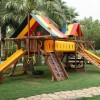 Coalitions form in communities to address complex issues and to take advantage of the resources and expertise of diverse people and groups. Sometimes coalitions may face difficult ethical dilemmas, and it helps for all members of the coalition to be aware of these issues. Learn about the 10-Step Decision-Making Model to use when making ethical decisions. This 8-page fact sheet was written by Martie Gillen, Carolyn S. Wilken, and Katey Walker, and published by the UF Department of Family, Youth, and Community Sciences, August 2012. http://edis.ifas.ufl.edu/fy664
Coalitions form in communities to address complex issues and to take advantage of the resources and expertise of diverse people and groups. Sometimes coalitions may face difficult ethical dilemmas, and it helps for all members of the coalition to be aware of these issues. Learn about the 10-Step Decision-Making Model to use when making ethical decisions. This 8-page fact sheet was written by Martie Gillen, Carolyn S. Wilken, and Katey Walker, and published by the UF Department of Family, Youth, and Community Sciences, August 2012. http://edis.ifas.ufl.edu/fy664
Tag: Family Youth and Community Sciences Department
Building a Spending Plan series
 Follow the six steps in this series to learn how to calculate your expenses and determine your financial goals. With this information, you can compare your expenses against your income to find out how to best budget your money. Fill out these worksheets to build your own spending plan. These fact sheets were written by Nayda I. Torres, Josephine Turner, and Brenda C. Williams, and published by the UF Department of Family, Youth, and Community Sciences, July 2012. http://edis.ifas.ufl.edu/topic_series_building_a_spending_plan
Follow the six steps in this series to learn how to calculate your expenses and determine your financial goals. With this information, you can compare your expenses against your income to find out how to best budget your money. Fill out these worksheets to build your own spending plan. These fact sheets were written by Nayda I. Torres, Josephine Turner, and Brenda C. Williams, and published by the UF Department of Family, Youth, and Community Sciences, July 2012. http://edis.ifas.ufl.edu/topic_series_building_a_spending_plan
Parents' Spending on Teens (FAR1209/FM421)
 “In a recent study from Teenage Research Unlimited, researchers reported that teens spent $159 billion in 2005. My own experience raising three teens led me to believe that many of them spent their parents’ money in 2005.” This 2-page Family Album Radio transcript was written by Donna Davis, and published by the UF Department of Family Youth and Community Sciences, July 2012.
“In a recent study from Teenage Research Unlimited, researchers reported that teens spent $159 billion in 2005. My own experience raising three teens led me to believe that many of them spent their parents’ money in 2005.” This 2-page Family Album Radio transcript was written by Donna Davis, and published by the UF Department of Family Youth and Community Sciences, July 2012.
http://edis.ifas.ufl.edu/fm421
Teen Birth Rates Decline (FAR1208/FM420)
 “Parents and others who are concerned about teenagers having babies have reason to celebrate. According to the nonprofit research organization Child Trends, the teenage birth rate for 15-19 year olds is at the lowest point in over 40 years. This drop began in 1991 and has roceeded steadily so that it is now one-third lower than the 1991 peak. The other good news is that it continues to fall.” This 2-page Family Album Radio transcript was written by Suzanna Smith, and published by the UF Department of Family Youth and Community Sciences, July 2012.
“Parents and others who are concerned about teenagers having babies have reason to celebrate. According to the nonprofit research organization Child Trends, the teenage birth rate for 15-19 year olds is at the lowest point in over 40 years. This drop began in 1991 and has roceeded steadily so that it is now one-third lower than the 1991 peak. The other good news is that it continues to fall.” This 2-page Family Album Radio transcript was written by Suzanna Smith, and published by the UF Department of Family Youth and Community Sciences, July 2012.
http://edis.ifas.ufl.edu/fm420
Helping Your Child Adjust to Child Care: Child Care 3 (FAR0309/FM419)
 “Almost 13 million of the 18 million children younger than five years of age in the U.S. are in some form of regular childcare (Overturf Johnson, 2002). This means that millions of parents are finding ways to help their children adjust to being away from Mom or Dad and get used to a new routine and situation. Child development experts recommend a number of strategies, particularly in the early weeks of care.” This 2-page Family Album Radio transcript was written by Suzanna Smith, and published by the UF Department of Family Youth and Community Sciences, July 2012.
“Almost 13 million of the 18 million children younger than five years of age in the U.S. are in some form of regular childcare (Overturf Johnson, 2002). This means that millions of parents are finding ways to help their children adjust to being away from Mom or Dad and get used to a new routine and situation. Child development experts recommend a number of strategies, particularly in the early weeks of care.” This 2-page Family Album Radio transcript was written by Suzanna Smith, and published by the UF Department of Family Youth and Community Sciences, July 2012.
http://edis.ifas.ufl.edu/fm419
Starting Child Care: Child Care 2 (FAR0308/FM418)
 “Many parents have suffered the heart-wrenching moment of dropping their baby at a new child care setting, only to have them cling and cry. If your child is starting child care, you can help make the transition easier by following a few guidelines from child development experts to help you and your child prepare for this change” This 2-page Family Album Radio transcript was written by Suzanna Smith, and published by the UF Department of Family Youth and Community Sciences, July 2012.
“Many parents have suffered the heart-wrenching moment of dropping their baby at a new child care setting, only to have them cling and cry. If your child is starting child care, you can help make the transition easier by following a few guidelines from child development experts to help you and your child prepare for this change” This 2-page Family Album Radio transcript was written by Suzanna Smith, and published by the UF Department of Family Youth and Community Sciences, July 2012.
http://edis.ifas.ufl.edu/fm418
Balancing Work and Caregiving: A Guide for Employers (FCS2261/FY873)
 Over 4 million people in Florida care for older family members or friends, and these people often must balance work and home responsibilities. Employers need to be aware of how to support their employees who are also caregivers. This could include support programs for caregivers, flexible schedules, or other work accommodations. This 3-page fact sheet was written by Martie Gillen and Carolyn S. Wilken, and published by the UF Department of Family, Youth, and Community Sciences, August 2012. http://edis.ifas.ufl.edu/fy873
Over 4 million people in Florida care for older family members or friends, and these people often must balance work and home responsibilities. Employers need to be aware of how to support their employees who are also caregivers. This could include support programs for caregivers, flexible schedules, or other work accommodations. This 3-page fact sheet was written by Martie Gillen and Carolyn S. Wilken, and published by the UF Department of Family, Youth, and Community Sciences, August 2012. http://edis.ifas.ufl.edu/fy873
Old Maid No More (FAR3038/FM416)
 “Twenty years ago, women were being warned that, according to demographic research, if they didn’t marry by the time they were in their early twenties, they would likely live out their lives unwed. As a child, I was even told that “those” women became “old maids,” and I feared a similar fate. Fast-forward to 2006, and the news is quite different.” This 2-page Family Album Radio transcript was written by Donna Davis, and published by the UF Department of Family Youth and Community Sciences, July 2012.
“Twenty years ago, women were being warned that, according to demographic research, if they didn’t marry by the time they were in their early twenties, they would likely live out their lives unwed. As a child, I was even told that “those” women became “old maids,” and I feared a similar fate. Fast-forward to 2006, and the news is quite different.” This 2-page Family Album Radio transcript was written by Donna Davis, and published by the UF Department of Family Youth and Community Sciences, July 2012.
http://edis.ifas.ufl.edu/fm416
Doctor Appointment Checklist (FCS2236/FY746)
 When you have a doctor appointment, you should make the most of your time with the doctor. This worksheet will help you remember what questions you want to ask and give you a space to take notes. This document is also beneficial if you are a caregiver for an older adult and go along to appointments. This 5-page fact sheet was written by Martie Gillen and Carolyn S. Wilken, and published by the UF Department of Family, Youth, and Community Sciences, August 2012. http://edis.ifas.ufl.edu/fy746
When you have a doctor appointment, you should make the most of your time with the doctor. This worksheet will help you remember what questions you want to ask and give you a space to take notes. This document is also beneficial if you are a caregiver for an older adult and go along to appointments. This 5-page fact sheet was written by Martie Gillen and Carolyn S. Wilken, and published by the UF Department of Family, Youth, and Community Sciences, August 2012. http://edis.ifas.ufl.edu/fy746
Playing It Safe with Play Equipment (FAR0086/FM415)
 “Raising my rough-and-tumble children at times took superhuman energy, patience, and constant supervision. Even the joyful vision of a playground could be daunting when the swing was used as a human slingshot and the slide had 101 uses, of which only one was acceptable. I’m sure many parents can relate to the fear of the unknown dangers on the playground.” This 2-page Family Album Radio transcript was written by Donna Davis, and published by the UF Department of Family Youth and Community Sciences, July 2012.
“Raising my rough-and-tumble children at times took superhuman energy, patience, and constant supervision. Even the joyful vision of a playground could be daunting when the swing was used as a human slingshot and the slide had 101 uses, of which only one was acceptable. I’m sure many parents can relate to the fear of the unknown dangers on the playground.” This 2-page Family Album Radio transcript was written by Donna Davis, and published by the UF Department of Family Youth and Community Sciences, July 2012.
http://edis.ifas.ufl.edu/fm415
Sun Protection for Your Children (FAR0084/FM412)
 “My children were all born during the summer months, and as we gradually spent more and more time outside, I wondered how best to protect them from the hot summer sun.” This 2-page Family Album Radio transcript was written by Suzanna Smith, and published by the UF Department of Family Youth and Community Sciences, July 2012.
“My children were all born during the summer months, and as we gradually spent more and more time outside, I wondered how best to protect them from the hot summer sun.” This 2-page Family Album Radio transcript was written by Suzanna Smith, and published by the UF Department of Family Youth and Community Sciences, July 2012.
http://edis.ifas.ufl.edu/fm412
Questions to Ask Before Agreeing to Surgery (FCS2235/FY745)
 Before you agree to have surgery, you need to be aware of the risks and benefits. The best way to do this is to discuss the surgery with your doctor. Use this worksheet to ask questions and take notes so that you have all the information you need. This 3-page fact sheet was written by Martie Gillen and Carolyn S. Wilken, and published by the UF Department of Family, Youth, and Community Sciences, August 2012. http://edis.ifas.ufl.edu/fy745
Before you agree to have surgery, you need to be aware of the risks and benefits. The best way to do this is to discuss the surgery with your doctor. Use this worksheet to ask questions and take notes so that you have all the information you need. This 3-page fact sheet was written by Martie Gillen and Carolyn S. Wilken, and published by the UF Department of Family, Youth, and Community Sciences, August 2012. http://edis.ifas.ufl.edu/fy745
Final Wishes: End-of-Life Decisions (FCS2262/FY874)
 As you grow older, you should discuss your final wishes with your family members so they will know what type of medical care you will want. The Five Wishes program and brochure present an easy way to communicate these decisions to your family and create a legal document. This 3-page fact sheet was written by Martie Gillen and Carolyn S. Wilken, and published by the UF Department of Family, Youth, and Community Sciences, August 2012. http://edis.ifas.ufl.edu/fy874
As you grow older, you should discuss your final wishes with your family members so they will know what type of medical care you will want. The Five Wishes program and brochure present an easy way to communicate these decisions to your family and create a legal document. This 3-page fact sheet was written by Martie Gillen and Carolyn S. Wilken, and published by the UF Department of Family, Youth, and Community Sciences, August 2012. http://edis.ifas.ufl.edu/fy874
9 Habilidades importantes de la comunicacion para cada relacion (FCS2315Span/FY1333)
 La comunicación efectiva es esencial para las relaciones exitosas. Investigadores y terapistas han encontrado que hay al menos nueve habilidades que pueden ayudar a las parejas a aprender a hablar efectivamente acerca de problemas importantes. Si aprende bien estas nueve habilidades puede ayudar a poner las relaciones en una trayectoria positiva al éxito. This 4-page fact sheet was written by Victor William Harris, and published by the UF Department of Family Youth and Community Sciences, July 2012.
La comunicación efectiva es esencial para las relaciones exitosas. Investigadores y terapistas han encontrado que hay al menos nueve habilidades que pueden ayudar a las parejas a aprender a hablar efectivamente acerca de problemas importantes. Si aprende bien estas nueve habilidades puede ayudar a poner las relaciones en una trayectoria positiva al éxito. This 4-page fact sheet was written by Victor William Harris, and published by the UF Department of Family Youth and Community Sciences, July 2012.
http://edis.ifas.ufl.edu/fy1333
10 Reglas del conflicto constructivo (FCS2314Span/FY1332)
 Determinar cómo manejamos los conflictos – constructivamente o destructivamente- es un buen camino para saber que tan funcionales o disfuncionales actuamos en las relaciones. Tómese un minuto para contestar la prueba que se encuentra a continuación para ver si maneja los conflictos de una forma constructiva o destructiva. Esto le ayudará a darse cuenta que está haciendo bien y en cuáles habilidades podría trabajar un poco más. This 4-page fact sheet was written by Victor William Harris, and published by the UF Department of Family Youth and Community Sciences, July 2012.
Determinar cómo manejamos los conflictos – constructivamente o destructivamente- es un buen camino para saber que tan funcionales o disfuncionales actuamos en las relaciones. Tómese un minuto para contestar la prueba que se encuentra a continuación para ver si maneja los conflictos de una forma constructiva o destructiva. Esto le ayudará a darse cuenta que está haciendo bien y en cuáles habilidades podría trabajar un poco más. This 4-page fact sheet was written by Victor William Harris, and published by the UF Department of Family Youth and Community Sciences, July 2012.
http://edis.ifas.ufl.edu/fy1332
Ocho necesidades de la pareja, el padre y el hijo (FCS2313Span/FY1331)
 Cuando las personas, las parejas y los padres aprenden cómo satisfacer sus necesidades personales consistentemente, pueden ayudar a otros y a sus hijos a satisfacer sus propias necesidades. This 4-page fact sheet was written by Victor William Harris, and published by the UF Department of Family Youth and Community Sciences, July 2012.
Cuando las personas, las parejas y los padres aprenden cómo satisfacer sus necesidades personales consistentemente, pueden ayudar a otros y a sus hijos a satisfacer sus propias necesidades. This 4-page fact sheet was written by Victor William Harris, and published by the UF Department of Family Youth and Community Sciences, July 2012.
http://edis.ifas.ufl.edu/fy1331
Living with Diabetes (FCS8706/FY334)
 Diabetes is a disease that affects more than 26 million Americans. Although there is no cure for type 1 or type 2 diabetes, diabetes can be managed with the proper care. If you have diabetes, the best way to live well is to learn about the disease and work with your doctor to develop a healthy living plan that is right for you. This 4-page fact sheet was written by Nancy J. Gal and Linda B. Bobroff, and published by the UF Department of Family Youth and Community Sciences, July 2012.
Diabetes is a disease that affects more than 26 million Americans. Although there is no cure for type 1 or type 2 diabetes, diabetes can be managed with the proper care. If you have diabetes, the best way to live well is to learn about the disease and work with your doctor to develop a healthy living plan that is right for you. This 4-page fact sheet was written by Nancy J. Gal and Linda B. Bobroff, and published by the UF Department of Family Youth and Community Sciences, July 2012.
http://edis.ifas.ufl.edu/fy334
Preparing Healthful Ethnic Foods (FCS8757/FY343)
 Eating a variety of nutrient-rich foods helps you get the nutrients you need to look and feel your best. One tasty way to increase variety in your food choices is to include ethnic foods like Chinese, Mexican, Italian, Greek, and others. How do you know that you are making healthy choices when you eat these foods? This 3-page fact sheet was written by Linda B. Bobroff and R. Elaine Turner, and published by the UF Department of Family Youth and Community Sciences, June 2012.
Eating a variety of nutrient-rich foods helps you get the nutrients you need to look and feel your best. One tasty way to increase variety in your food choices is to include ethnic foods like Chinese, Mexican, Italian, Greek, and others. How do you know that you are making healthy choices when you eat these foods? This 3-page fact sheet was written by Linda B. Bobroff and R. Elaine Turner, and published by the UF Department of Family Youth and Community Sciences, June 2012.
http://edis.ifas.ufl.edu/fy343
Teen Dating on the Decline (FAR1207/FM409)
 “Ah, the first date! This is coming up soon for some of my teenage friends. Chances are they will be excited—and nervous, too. And it’s no wonder. Child and family experts say that dating is a major change and one of the more challenging adjustments teens face.” This 2-page Family Album Radio transcript was written by Suzanna Smith, and published by the UF Department of Family Youth and Community Sciences, July 2012.
“Ah, the first date! This is coming up soon for some of my teenage friends. Chances are they will be excited—and nervous, too. And it’s no wonder. Child and family experts say that dating is a major change and one of the more challenging adjustments teens face.” This 2-page Family Album Radio transcript was written by Suzanna Smith, and published by the UF Department of Family Youth and Community Sciences, July 2012.
http://edis.ifas.ufl.edu/fm409
Breastfeeding during Disaster (FAR0430/FM429)
 “As we’ve learned over the past couple of years, disaster can strike anyone, anywhere, and anytime. A natural disaster, whether hurricane, tornado, flood, or tsunami, can devastate areas and leave families without resources, sometimes for long periods of time. And while people of all ages suffer, infants can be at far greater risk. However, mothers can save their infants’ lives and protect them from illness by simply breastfeeding, even if they haven’t been breastfeeding their baby.” This 2-page Family Album Radio transcript was written by Donna Davis, and published by the UF Department of Family Youth and Community Sciences, July 2012.
“As we’ve learned over the past couple of years, disaster can strike anyone, anywhere, and anytime. A natural disaster, whether hurricane, tornado, flood, or tsunami, can devastate areas and leave families without resources, sometimes for long periods of time. And while people of all ages suffer, infants can be at far greater risk. However, mothers can save their infants’ lives and protect them from illness by simply breastfeeding, even if they haven’t been breastfeeding their baby.” This 2-page Family Album Radio transcript was written by Donna Davis, and published by the UF Department of Family Youth and Community Sciences, July 2012.
http://edis.ifas.ufl.edu/fm429